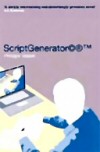“Script Generator©®™,” by Philippe Vasset

Review of Philippe Vasset, Script Generator;©®™, translated by Jane Metter, Serpent’s Tail Press, 2004.
A review by James Kohn.
Just as the film “Last Year at Marienbad” teased an earlier generation with its innovative and creative story-telling, so Philippe Vasset’s hyper-novel teases the modern-day reader of adventure fiction. For the chapters of this novel of intrigue are interspersed with pages taken from a presumed software product, the “Script Generator” of the title.
The premise of the novel is that a certain valuable commodity must be found and exploited, as the first-person narrator tumbles from one context to another, always in a doubtful and challenging environment, always confronted by ambiguities and hidden meanings, and always led back to the “printed manual on watery green-colored glazed paper” which turns out to be the software product blurb. At the end of the short book, the reader is let in on the secret: “ScriptGenerator©®™ has produced the story which features in between the chapters of this manual.” (p. 101) One is not even certain that the dubious English of this revealing sentence is an invention of the writer or of the translator, such is the baffling and intriguing nature of the book.
There are many layers to the book, ready for the reader to peel away. The text of the software promotional material that alternates with the pages of fiction reads as a parody of commercial software: “ScriptGenerator©®™ applied these avant-garde techniques which have proved themselves on both the London and Chicago Stock Exchanges, to the narrative market. Using low-cost techniques, ScriptGenerator©®™ fills in storylines with recycled narrative twists.” (p. 17) So the narrative voice in the commercial blurb invites the reader to compare the production of a novel with the production of commodities and products, and to note that software products could make production of creative works more efficient, as if efficiency were the main criterion in creative work.
This bold experiment in creativity invites us to unravel several puzzles: Is fiction writing more than the interweaving of familiar plot lines and formulas? If there is no more to fiction writing than manipulating plot lines and settings, what is the true nature of good writing? The success of mystery and intrigue writers and writers of romance fiction who repeatedly use familiar plot lines and scenarios seem to draw success from their formulas, and indeed their books become commercial commodities. The overwhelming success of the Harry Potter books shows us clearly how well such formulas can work; J.K. Rowling has her own script generator in her head. But we notice as we read the text reviewed here that the fiction included within it is ambiguous, and that the reader may become disoriented as the plot appears to jump from locale to locale with every chapter of fiction, with only tenuous links to previous chapters. The fiction chapters provide a clear illustration that merely manipulating plot lines and locales may result in recognizable fiction, but not a good novel. Thus the book is an effective illustration of the limits of the imagined “script generator,” and by extension, the limits of the production approach to creative work. Just as “production art” that appears on the walls of hotel rooms may be classified in broad terms as “artwork,” yet leaves the viewer unmoved, so the fiction produced by such a script generator may be called “fiction,” but it does not qualify as creative.
So what was the author’s intention in writing the book? It is clearly a savage parody of the commercialism of contemporary culture, and of the publishing industry’s role. It may have been an attempt to show the vapidity of the writers of currently popular fiction. It may have been an attempt to illustrate the corruptive values of a material society, so entranced with valuing products on the basis of cost effectiveness that it will soon move to absurd conclusions. It may also have been a diatribe aimed at fellow authors, who so closely attach themselves to the strategies of commodity-moving used by book publishers that they begin to write commercially-adapted stories as commodities.
This work is fascinating, but hard to classify. In its parody of novel writing, it integrates social commentary, an art critique and an illustration of fiction.
About the Reviewer:
Prof. James Kohn is Chair of the English Department at San Francisco State University and Head of the Editorial Board for the San Francisco Humanities Review. His research involves the pedagogical and cultural issues raised in preparing students to teach English to speakers of other languages (TESOL), including courses in sociolinguistics, second language acquisition, and TESOL pedagogy. He also occasionally teaches post-colonial literature, the teaching of literature to language learners, and composition for English learners. His current interest is in the pedagogy of the Internet for English-language teaching. His publications include ESOL textbooks, articles in the TESOL Quarterly, and in Language and Literature. He was for some 29 issues over 16 years an Editor of MAGAZINE, SFHR’s printed precursor.